German submarines, known as U-Boats, already proved their combat value during the First World War. Looking almost like shells against the backdrop of huge battleships, they wreaked havoc and proved to be the most dangerous weapon that almost brought Britain to its knees.
Were they able to renew their success during the next war? Compared to the British invented Asdic, i.e. a device capable of locating a submerged submarine, did they still have a right to exist? Oh how! And again, at least in the first half of the war, they took their heavy toll. Maybe not honorably, hidden like a camouflaged sniper, but still effective ...
Against the background of the entire large fleet of U-boats, the U-107 deserves special mention as it obtained the best result achieved by a single submarine of any country during this war .
An unusual ship
The U-107 was an IXB U-boat. Its ocean range could be up to 1,500 nautical miles (2,778 km). In total, only 14 ships of this type were built. Its successor was the Type IXC - even more modified compared to the original Type IX.
In addition to the impressive range, the Type IXB U-Boats were able to carry as many as 22 torpedoes on board! For comparison, the VIIC type - the most popular type of U-boat, commonly known as the "Dönitz workhorse", took only 14 torpedoes on board.
The U-107 was launched on July 2, 1940, and commissioned at the beginning of August. The ship was incorporated into the 2nd U-Boat Flotilla based in Lorient (France).
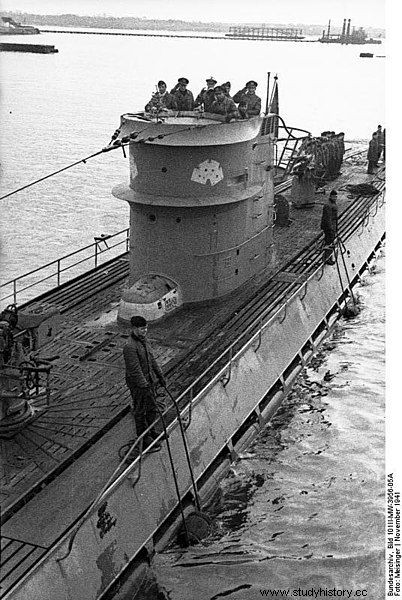
U-107 in Lorient
From the very beginning of service, the U-107 can be considered an extraordinary ship because ... it was commanded by the son-in-law of Karl Dönitz himself - the commander-in-chief of the German U-Bootwaffe, whose U-boat crews used to be called the "Great Lion". Günter Hessler married Dönitz's daughter Ursula in November 1937. Hessler joined Kregsmarine in 1927 and initially served in torpedo boats and then in battleship Schlesin. He came to the U-Boats in April 1940 and after only six months he was delegated to the position of commander. His ship was U-107.
It is noteworthy that some literature reports that Dönitz's son-in-law was also Adi Schnee, but the "Big Lion" had only one daughter and her husband was just Hessler.
The very fact that Hessler took command in such a short period of time is quite remarkable, as the correct polishing was usually achieved first as an officer. His previous experience, however, spoke in his favor, and in the end it turned out to be the right thing to do. Already during its first patrol as commander, the U-107 succeeded in sinking four ships for a total of 18,514 tons.
On March 29, 1941, at the pier in Lorient, the ship shook, pounded the characteristic sounds of diesel engines, and the ship's bow turned towards the open sea. Initially, the ship was accompanied by U-94, but later separated from it, taking the southern course. Its operational area was the area between the Canary Islands and Freetown (Sierra Leone's largest city).
First success
On April 8, the British freighter Eskdene appeared in the sight of the U-107. It already survived the torpedo operation on December 2, 1939. Then he was hit by a single torpedo launched from the U-56. As the main cargo of the freighter was wood, despite serious leaks, the freighter managed to reach the port. It was thoroughly repaired. April 8 was supposed to be a less fortunate day for him…
In the morning hours, the convoy OG-57, sailing from Hull to Buenos Aires, was hit by two torpedoes south-east of the Azores. He was carrying a cargo of coal on board. And this time he did not want to sink. The U-107 crew did not intend to "release the wounded animal from the trap" and arranged artillery training. After firing 104 missiles, she finally sank the freighter. Fortunately, none of the 39 crew died.
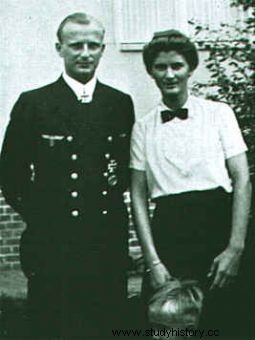
Günter Hessler with his wife Ursula
On the same day, another British freighter, Helena Margareta, belonging to the same convoy, approached the German torpedo tubes. The ship was sailing under ballast. At 19.40 there was a deaf explosion. Just one torpedo was enough to send the freighter to the bottom. This time 27 people died as a result of the attack. Only nine, including the captain, managed to survive.
The U-107 crew did not have much time to celebrate. Another combat alert was announced almost immediately. Just after midnight, another British Harpathian freighter was attacked. On board it transported RAF materials. Two torpedoes, colloquially referred to by the German crews as "fish" or "eels", proved effective and sank the target under attack. Four people died as a result of the attack. Another 39 were saved.
On the same day in the evening (exactly 7.20 pm), U-107 attacked a "fatter bite" in the form of the British tanker Duffield. On board, it transported a valuable cargo of 11,700 tons of oil. His port of destination was Gibraltar.
U-107 attacked with two torpedoes, this time fired from the stern. Both proved accurate. As a result of the attack, the tanker stopped and caught fire, which ... after just one minute had passed, was gone. The tanker crew brought it back into service and soon it was able to reach a speed of 12 knots. As the U-Boat only had two stern tubes, it had to make a quick maneuver to attack from the bow tubes. The next attack was also successful. A hit in the midship and a bow were obtained but the tanker was still sailing ... It would be a sin to let go.
Hessler, with a heavy heart, decided to sacrifice the fifth precious "fish". At 3.45 am, it hit the engine room, broke the vessel in half, and then it sank. As far as the eye can see, the ocean is on fire. The attack claimed 25 lives. 28 crew members were saved.
In just two days, the U-107 managed to sink four ships weighing 13,194 tons.
Take a breath
Stagnation followed after an intense onset. Nothing meant that this patrol would go down in history. The days passed sluggishly and the patrol routine was devoid of fireworks. Until April 21. It was then that the huge British freighter Calchas appeared on the horizon. He sailed from Sydney to Liverpool. He was carrying general cargo on board, which included a cargo of wheat, butter and flour.
At 2:20 p.m., a freighter, stripped of an escort, received a hit amidships. As the wreck did not want to sink, the so-called coup de grâce was launched, which sank the target at 2:58 pm. 87 people managed to save themselves. 30 died. Two Chinese managed to swim ashore but died of exhaustion.
Interestingly, the commander of Hessler reported after the war that after the attack he swam up to sinking Calchas. His intention was to help the survivors, but his inner intuition kept the commander from going to the surface. As soon as he extended his periscope, commonly known as "asparagus" by the crews, the crew of the freighter got to the cannons and opened fire in the direction of the extended periscope. Hessler decided to retract the periscope and, managing the speed "full speed ahead", moved away from the sinking wreckage.
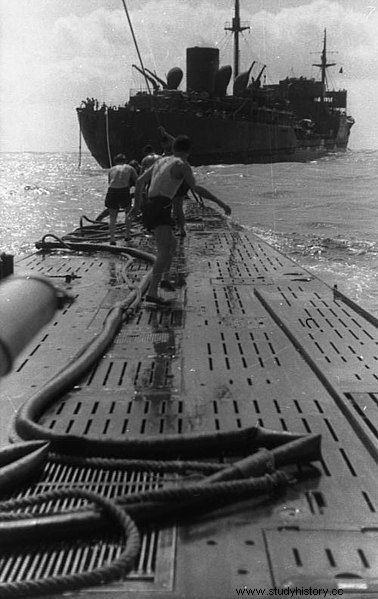
U 107 meets the supply ship
On April 30, the British moped Lassell fell victim to the attack. He sailed from Liverpool to Buenos Aires. He was transporting general cargo. It was hit at 21.55 in the port area of the engine room. The engines stopped. About 8 minutes after the attack, the ship sank stern down. However, the lifeboat was damaged due to the attack. Another suffered damage when it was left for sea. There were therefore only two lifeboats left for the crew. After three days, they lost contact with each other.
The first boat, which was the captain, second mate, 22 crew members and one woman, was found by the British freighter Benvrecki. The survivors were taken on board, but ... unfortunately, after only four days, he was under attack. This time the perpetrator of the torpedo was U-105. Another 15 people from Lassel died as a result of the attack. The captain and nine survivors were rescued after 13 days at sea.
The second lifeboat was more fortunate. On May 10, she was found by the freighter Egba. After the survivors were taken aboard, they were transported safely to Freetown.
On May 3, U-107 and U-105 found the German supply vessel Nordmark. Fuel and oil stocks were replenished. Five days later another meeting with the supplier was scheduled. This time it was Egerland disguised as an American freighter. Potatoes, canned fruit, bread, drinking water, oil and ... a valuable cargo in the form of 14 torpedoes were delivered to the U-Boat!
Torpedo… Fate!
On May 17, U-107 located another target. This time it was the Dutch tanker Marisa. It sailed under ballast from Freetown to Curacao. Shortly after midnight, the unescorted tanker was struck by a torpedo at the height of the engine room. An interesting fact is that the U-107 tracked its target from 12.49 the previous day.
After the hit, the tanker stopped, which allowed Hessler to take precise aim and another shot, this time from the stern tube. The coup de grâce occurred at 1.15 am after the crew had evacuated from the deck and deployed to three lifeboats.
After 15 minutes, the U-107 came to the surface and started firing at the wreckage from the on-board gun. 20 hits were scored, but then one of the shells exploded in the barrel, rendering the gun useless. Although the stern of the tanker slowly sank into the water, the bow was still afloat. Hessler ordered a 20mm AA (anti-aircraft) cannon to fire. And in this case a missile exploded in the barrel. She damaged the cannon. Only by a miracle no one from the staff was injured. Upset and disappointed, Hessler wrote in his logbook: What kind of weapons and ammunition we must use! Or one that we ourselves have to fear? ”
Eventually, the tanker sank and three lifeboats were found between May 20 and 23. Two people died in the attack.
Already in the evening of the next day, another target was located. It was the British freighter Piako, sailing from Australia via Freetown to Liverpool. The load consisted of:frozen products, zinc, butter, meat and 24 bags of mail. At 22.27 a lonely Piako was hit right under the captain's bridge. The freighter stopped, sent a hit signal and the crew began disembarking.
After 20 minutes, Hessler gave the injured unit a "kiss of death", hitting it, tearing its rudder off and finally sinking it. 10 crew members died and 65 were saved.
More
Hessler had to wait for his next victim until 27 May. It was then that the solitary British freighter Colonial was found. He was transporting general cargo. He sailed the route of Liverpool-Freetown-Beira (Mozambique). The first hit was made at 01.01. After the evacuation of the crew, they were asked to coup de grâce. The freighter sank quickly . The 100 crew members managed to evacuate and made it safely to Freetown.
The very next day, more torpedoes were waiting for a signal to catch up with the Greek freighter Papalemos. It was transporting a load of grain. At 2:52 pm, an explosion broke through the hull and damaged one lifeboat.
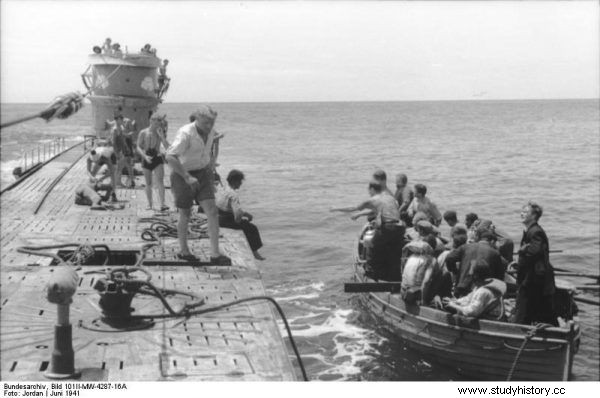
U-107 at sea
Immediately, the disembarkation began. At 4 p.m., having made sure that the entire crew was seated in three lifeboats, the shelling of the wreckage began from the repaired 20 mm cannon. They were fired just above the waterline. As the freighter began to sink, Hessler approached the survivors, asked them basic questions, provided the necessary medical supplies for the three wounded, and provided people with cigarettes and chocolate. He also gave them a proper course so that they could get to the nearest land as soon as possible. Two of the 29 crew died as a result of the attack.
The next sinking took place on May 31 at 7.39 am. A single torpedo hit the British freighter Sire under ballast. The explosion took place near the bow. Just 10 minutes was enough for the freighter to sink. Three people died and 46 were saved.
The next day, another target approached the U-boat launcher. It was the British freighter Alfred Jones. He transported valuable cargo in the form of planes for the RAF, trucks and 180 tons of steel. There were explosions at 09/14. Hessler allocated as many as three "eels" as he mistakenly qualified his target as a Q-ship or a trap ship. Half an hour after the attack, only the underwater sounds of the freighter breaking bulkheads were heard. 14 people out of 76 people died.
On June 8, 82 miles southwest of Freetown, U-107 launched an attack on a passenger ship. It was the British Adda. He had 424 people on board. The ship received a hit to the stern and slowly began to sink. It is a miracle that as many as 415 people managed to evacuate and survived the attack.
The last catch
The last victim of this patrol was the Greek freighter Pandias. It transported coal, military materials and 11 Spitfires. One torpedo was enough to sink the target under attack. This happened on June 13 at noon. After half an hour, there was no sign of him on the horizon.
At first, it seemed that the Greek freighter would be lucky on that day. U-Boat hunted him for 90 minutes , however, the densely driving rain caused problems with getting into a position convenient for firing a shot and caused temporary lack of contact. Undaunted by the problems, Hessler finally managed to properly position his ship, launch and thus seal the Greek's fate.
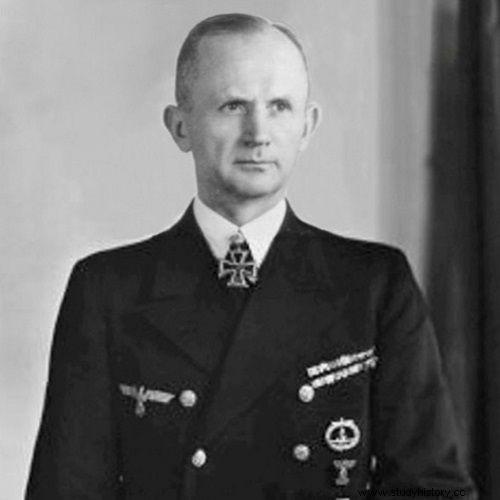
Karl Dönitz
Hessler surfaced his ship and approached the crowded lifeboat. Its captain - Petros Kontopoulos, honestly answered the questions put to him. They concerned the name of the vessel, cargo and the port of destination. Hessler then gave the survivors a course to the nearest land and provided them with cigarettes, drinking water and rum. The lifeboat had 500 nautical miles to cover. In the end, she managed to reach the shores of Guinea, except that almost immediately they fell into the hands of people belonging to the French Vichy. At least two people died during internment. The U-boat attack alone took 11 casualties.
It was the last - 14th ship sunk during this patrol by U-107.
The U-Boot had a chance for an even better result, as a meeting with another supply vessel was scheduled in mid-June. Randez-vous did not materialize, however, as the supply ship Lothringen was sunk by British ships.
Back
July 2 - after 95 days on patrol U-107 he dropped his lines in the port of Lorient. He sent 14 ships to the bottom, reaching 86,699 tons. He traveled 1,584 nautical miles in total, including 173 under water.
Reading the combat log, Karl Dönitz noted:Well done and a very successful patrol proving the abilities of the commander. He sent to the bottom almost all the targets he encountered on his way.
Despite his great achievements, Dönitz hesitated to award his son-in-law the Knight's Cross. He was afraid it would be frowned upon. The Goebbels propaganda tube also treated Hessler's success very cautiously, which she was definitely not in her habit of doing. The Grand Admiral Erich Reader, the commander-in-chief of the entire Kriegsmarine, freed Dönitz from this embarrassing situation. Hessler received a well-deserved award and the U-107 was undergoing a long renovation.
The U-107 made a total of 13 combat patrols. Until the end of the war, it was commanded by four commanders. Ultimately, the ship sank or damaged a total of 43 ships and a total of 243,424 tons.
Hessler served on the U-107 until December 1, 1941, and then transferred to the submarine headquarters. After the war, Hessler spent over a year in a POW camp. Then, in the years 1947-1951, he was appointed by the British Ministry of Defense to write a three-volume work on the activities of U-boats in the Atlantic. He did it together with the commander of the U-378 (Alfred Hoschatt).
He died on April 4, 1968.
